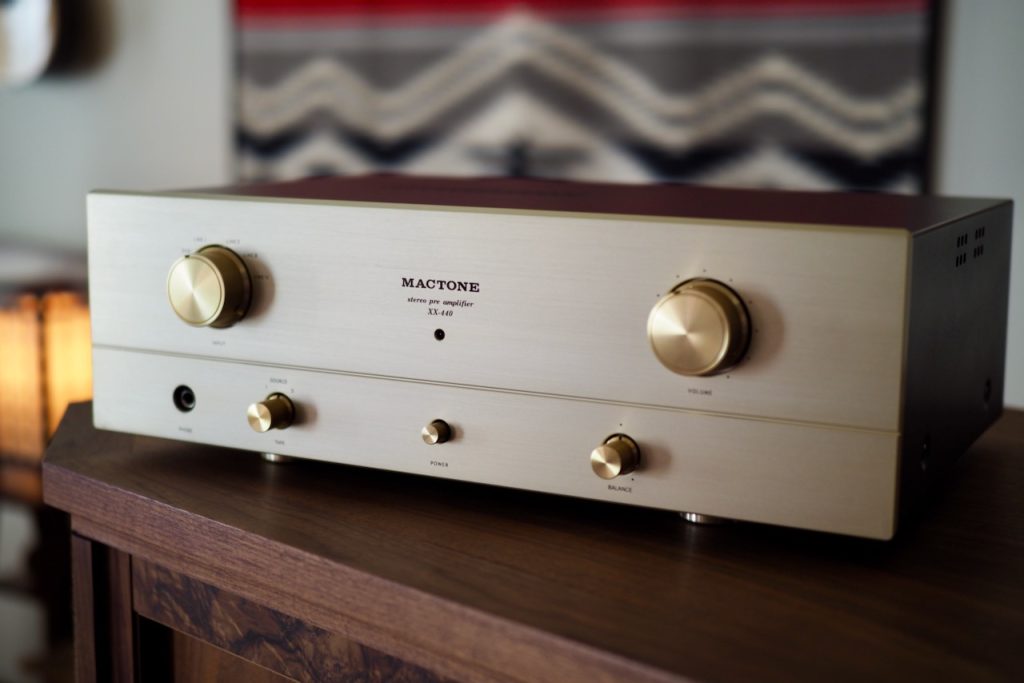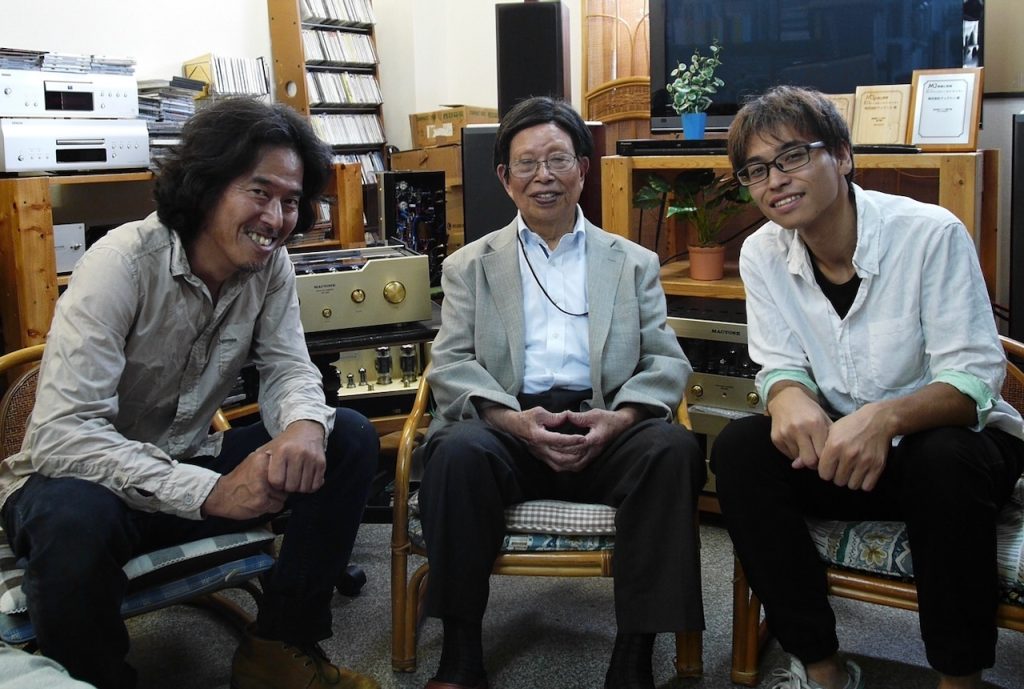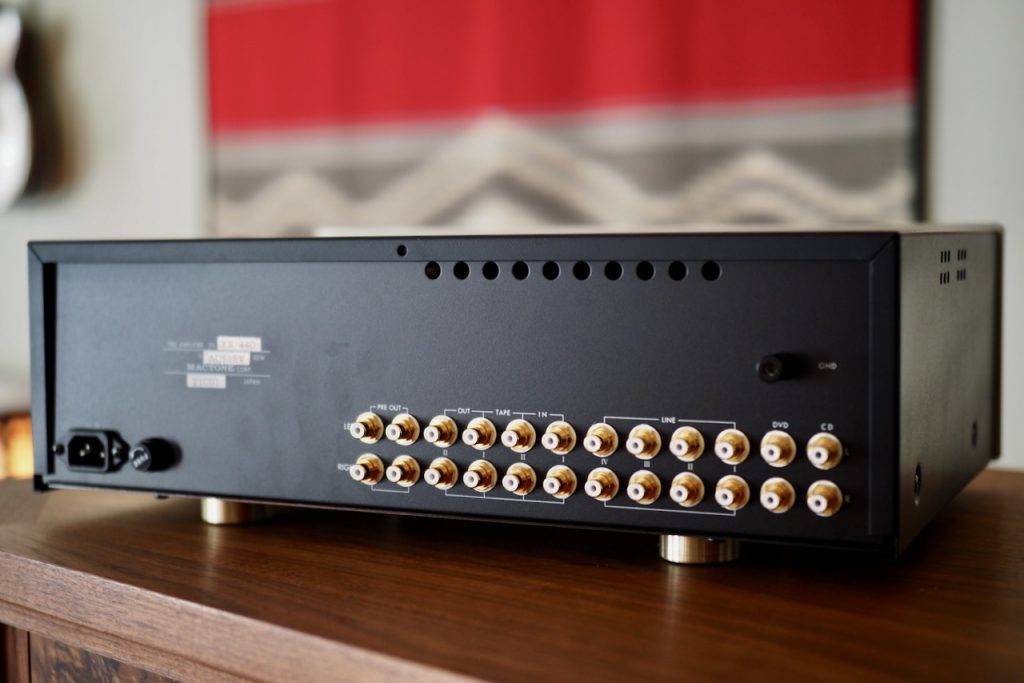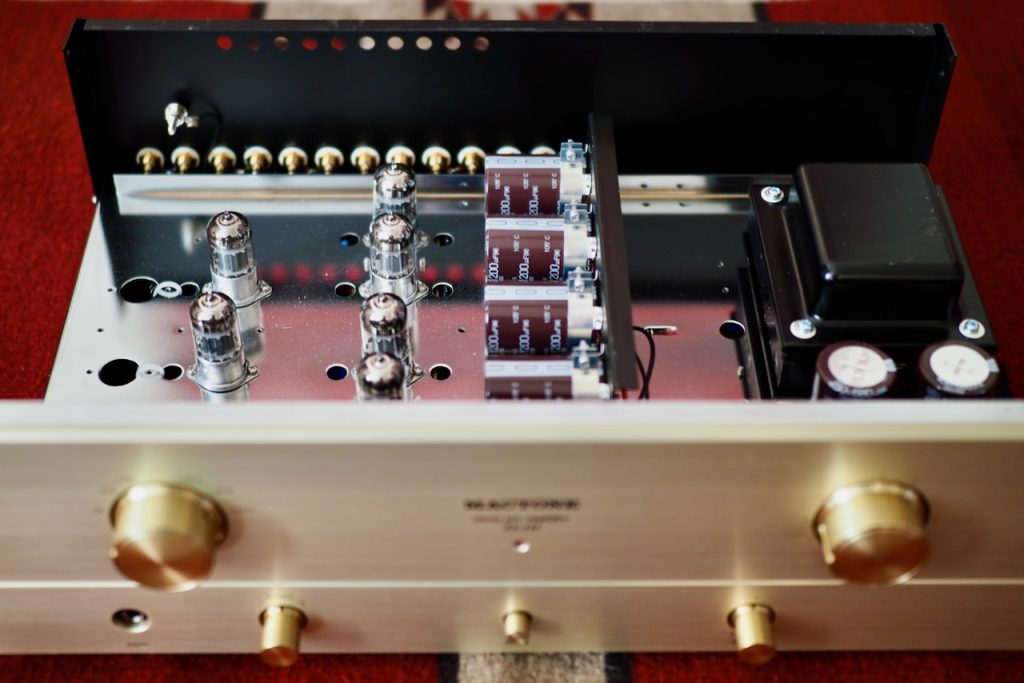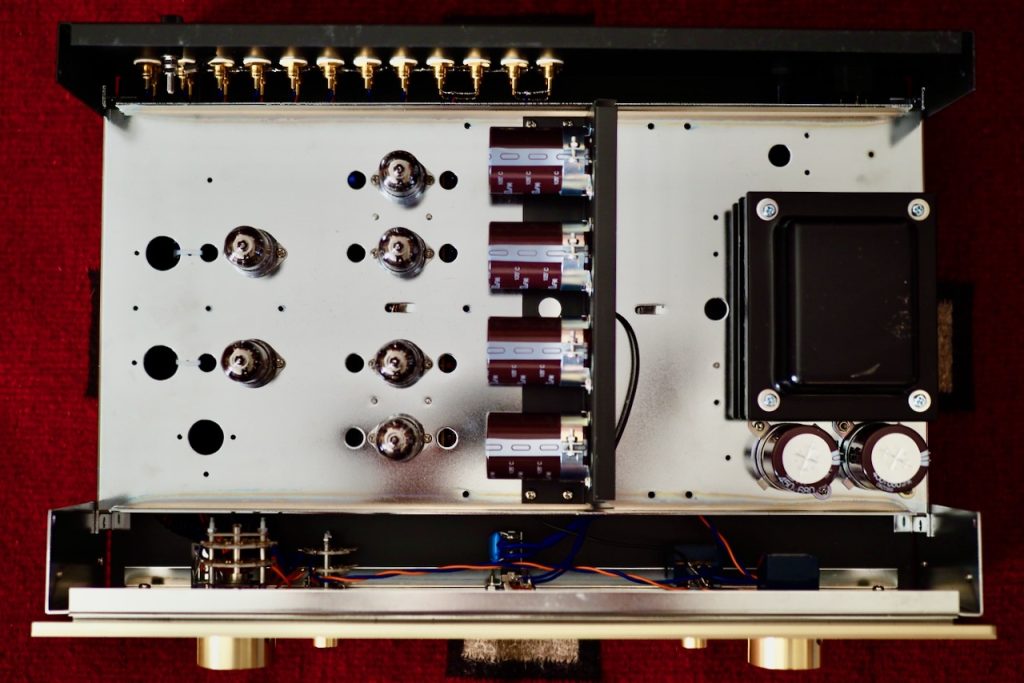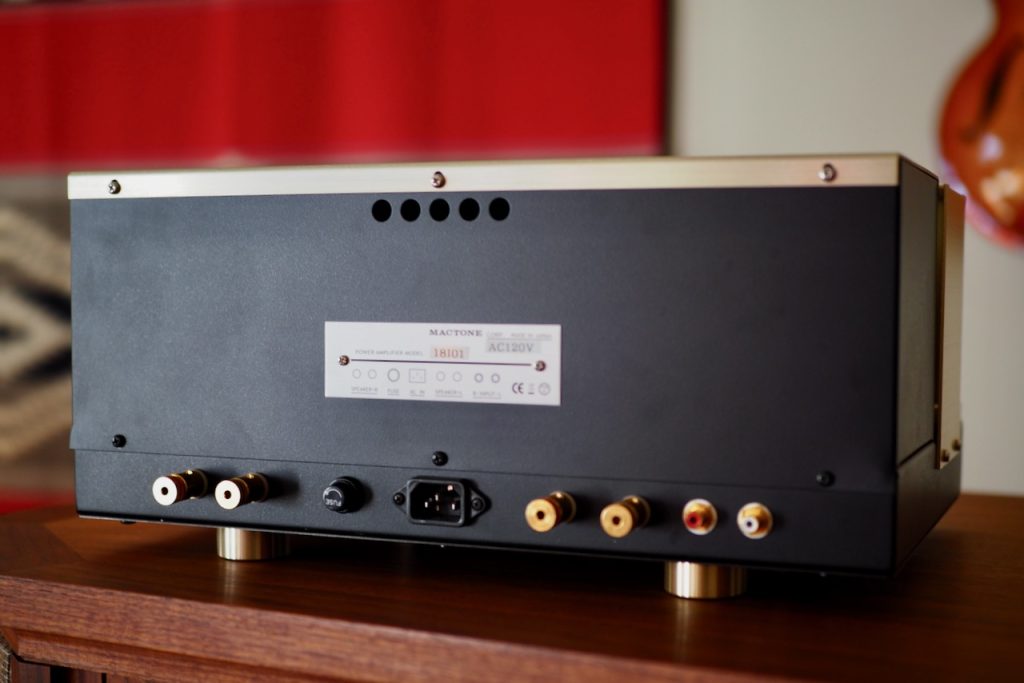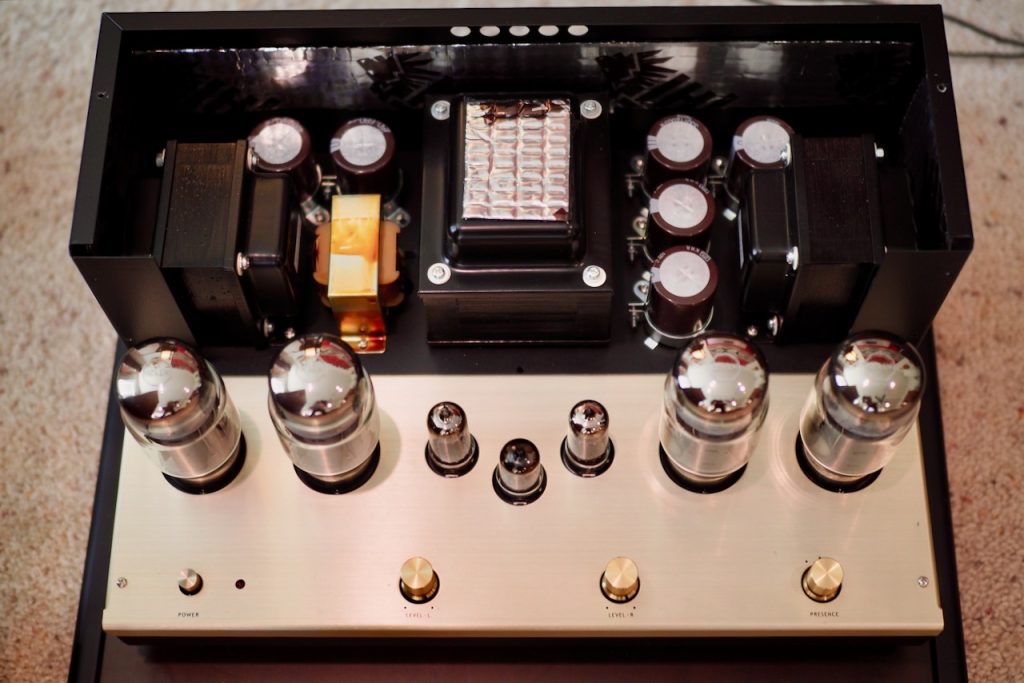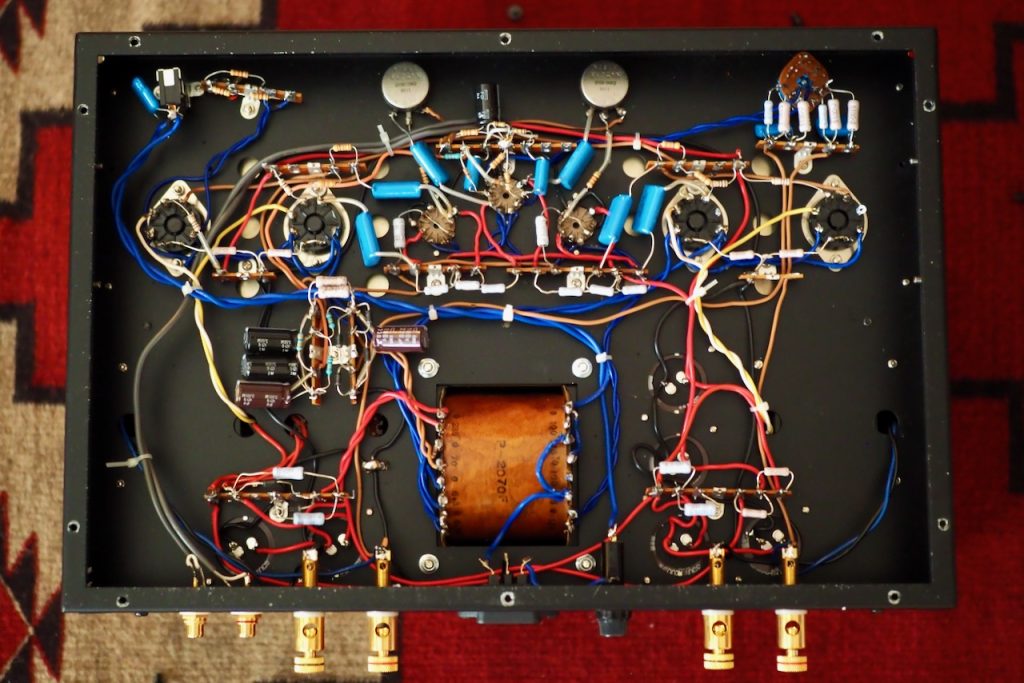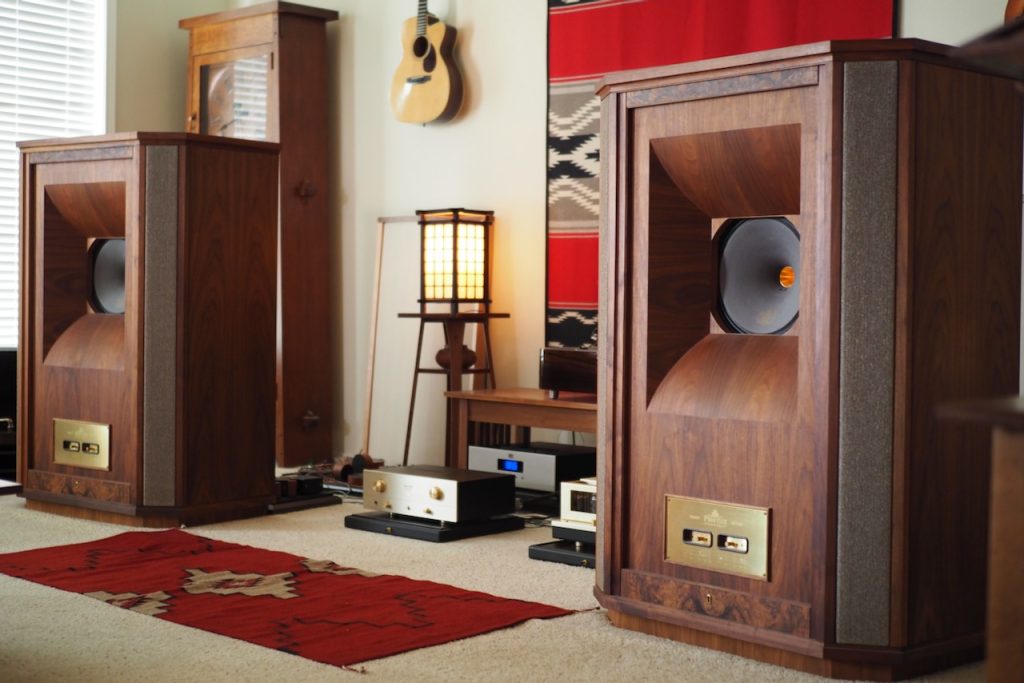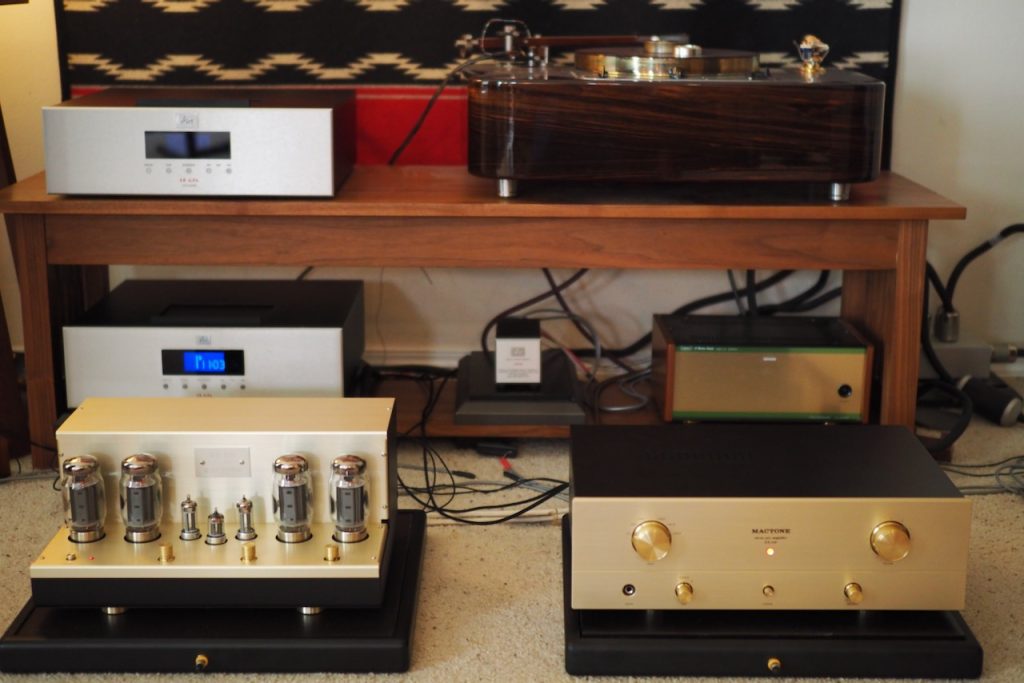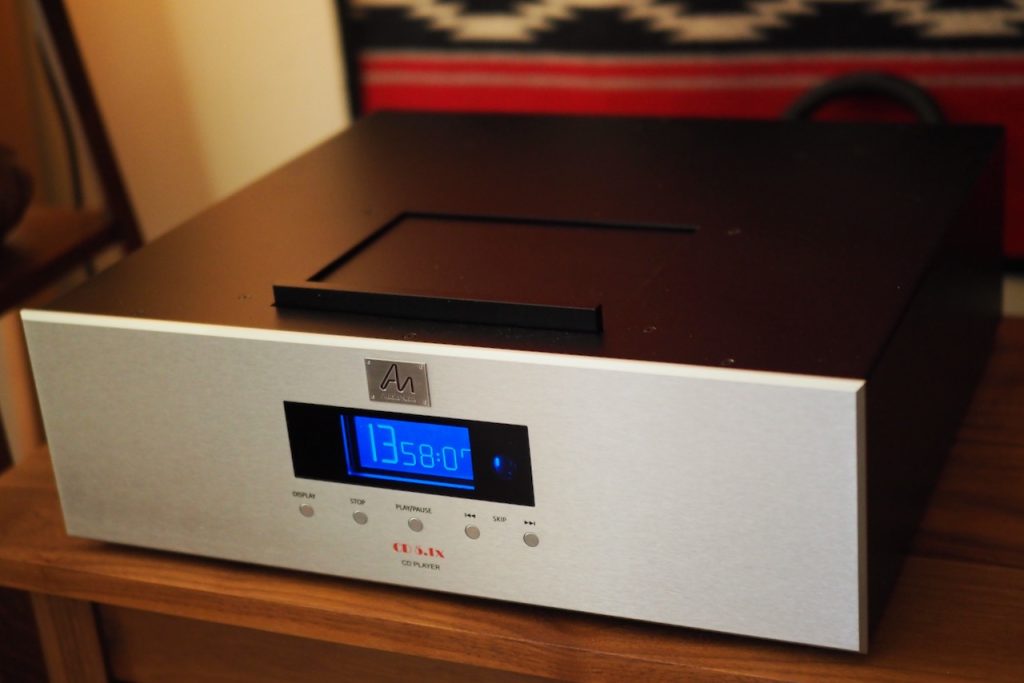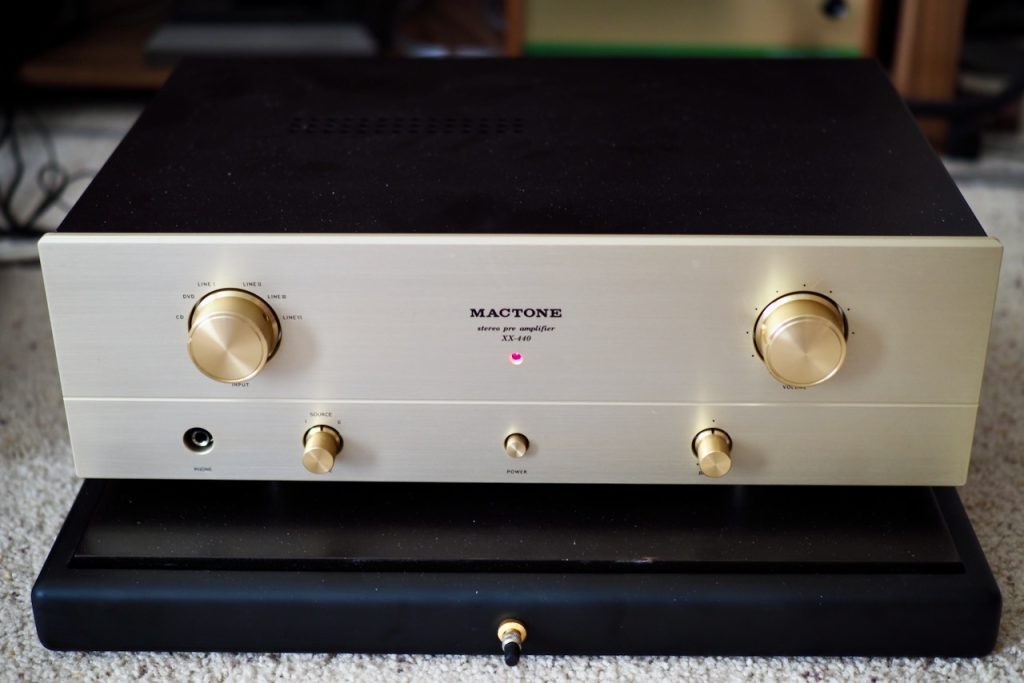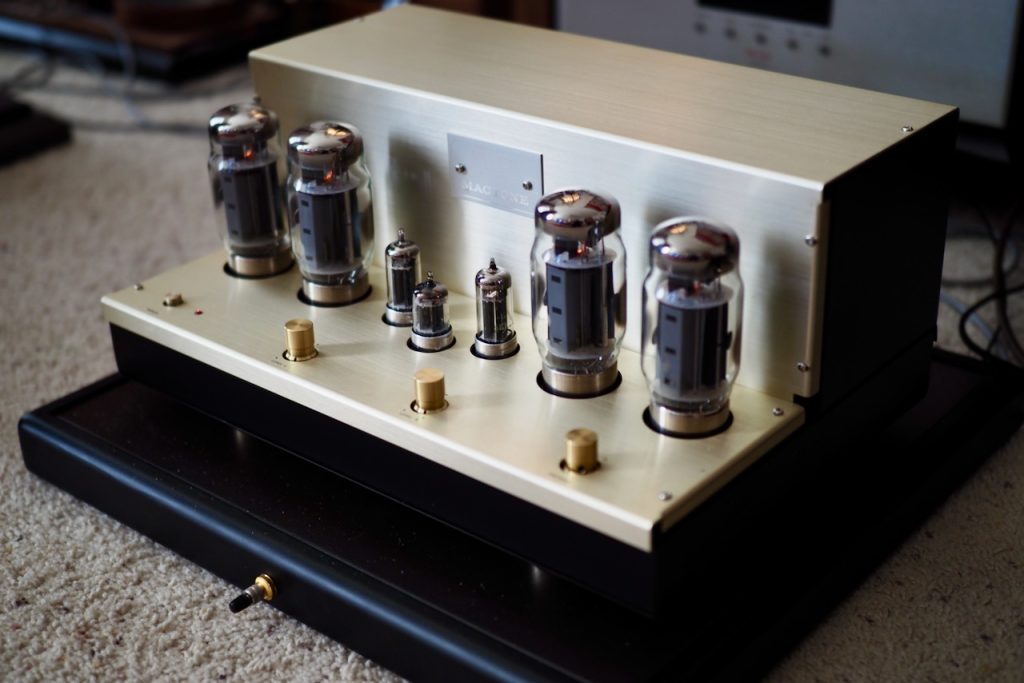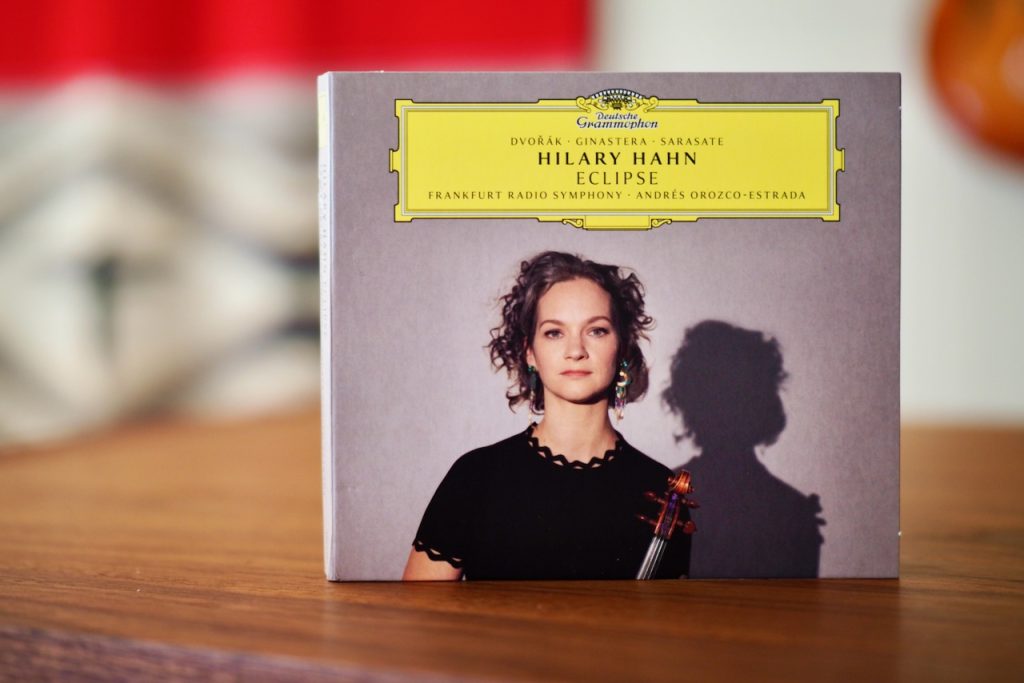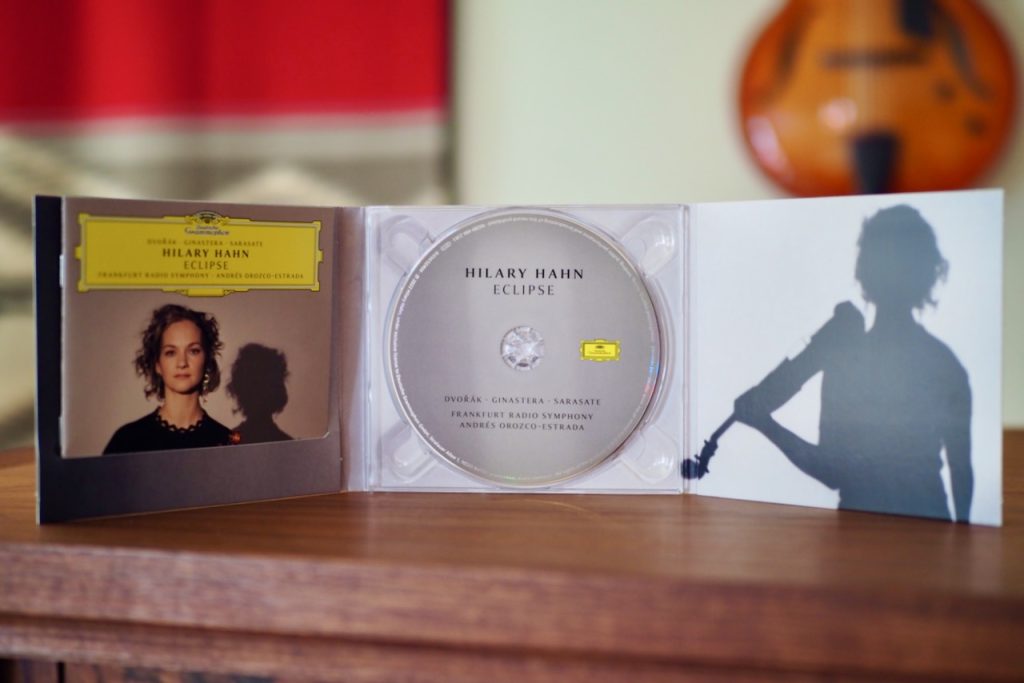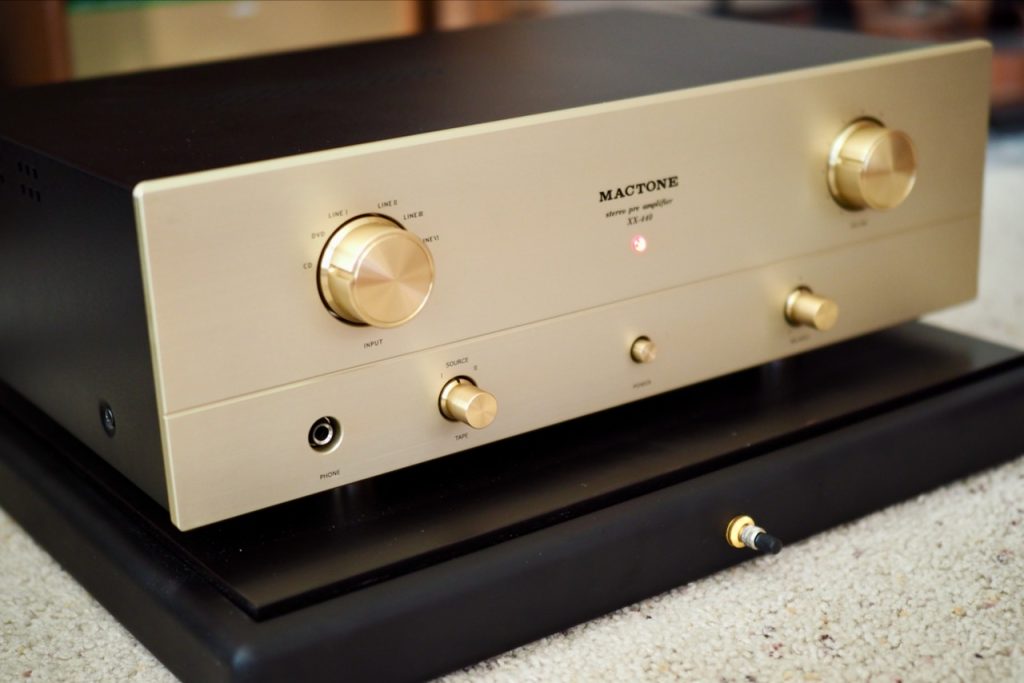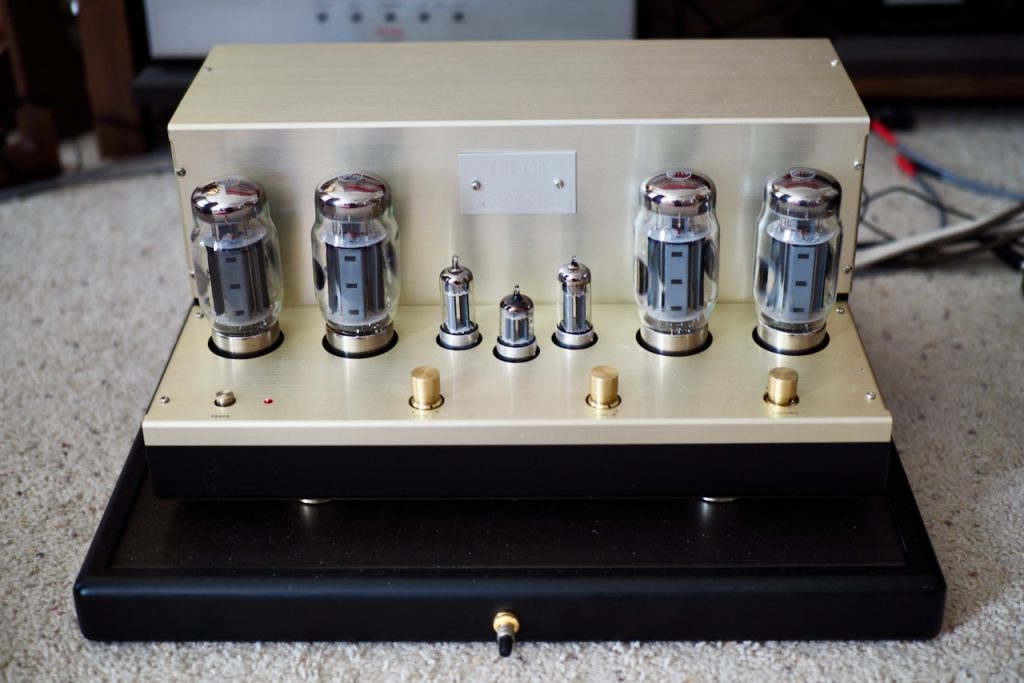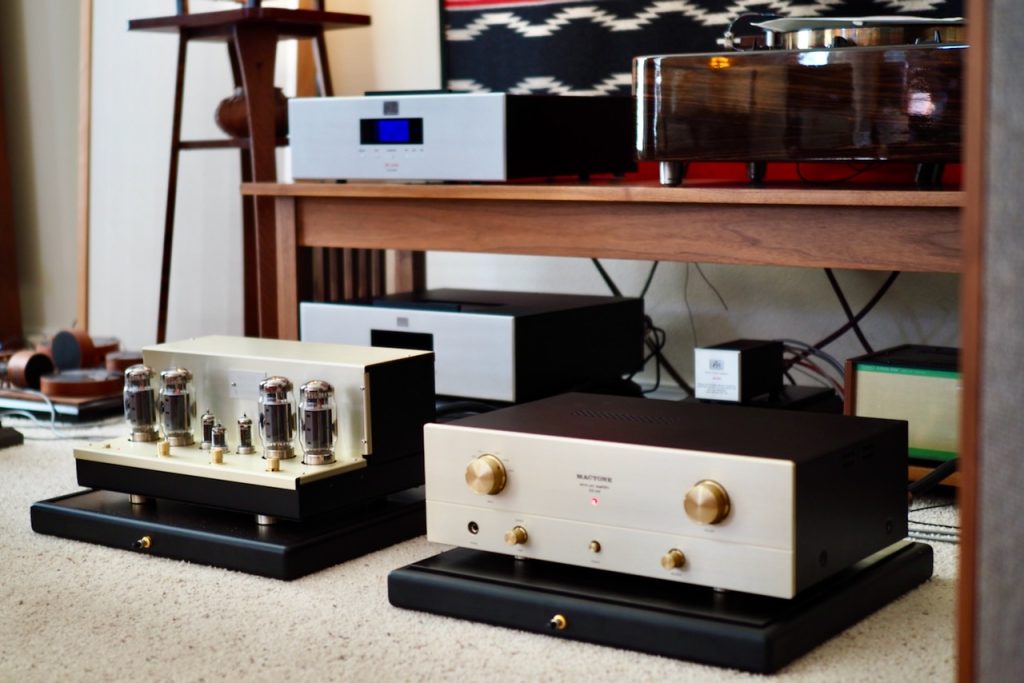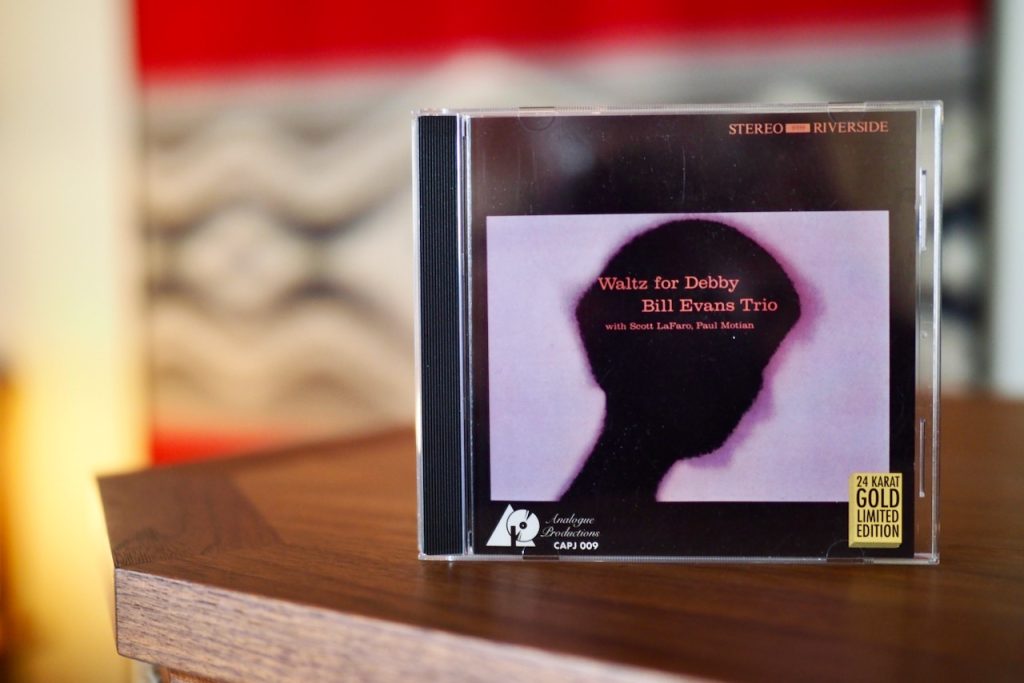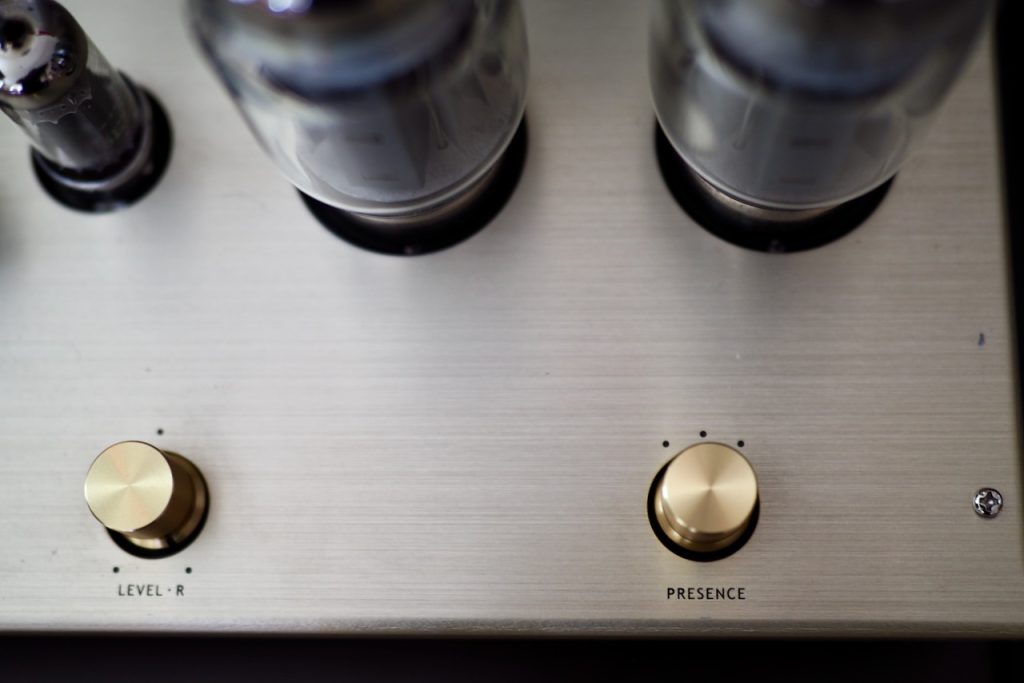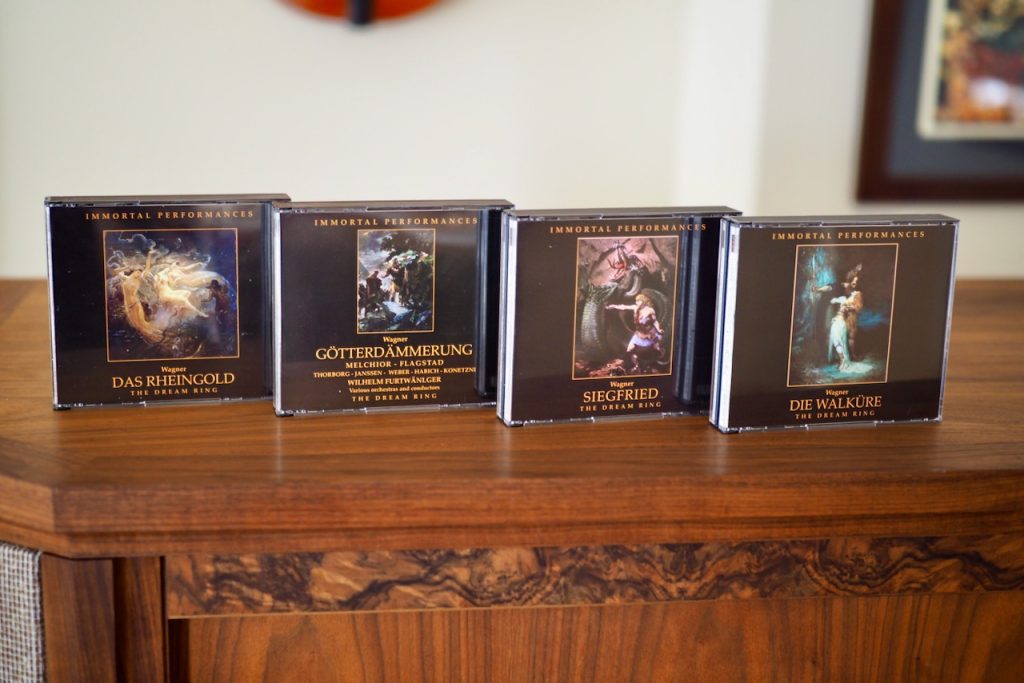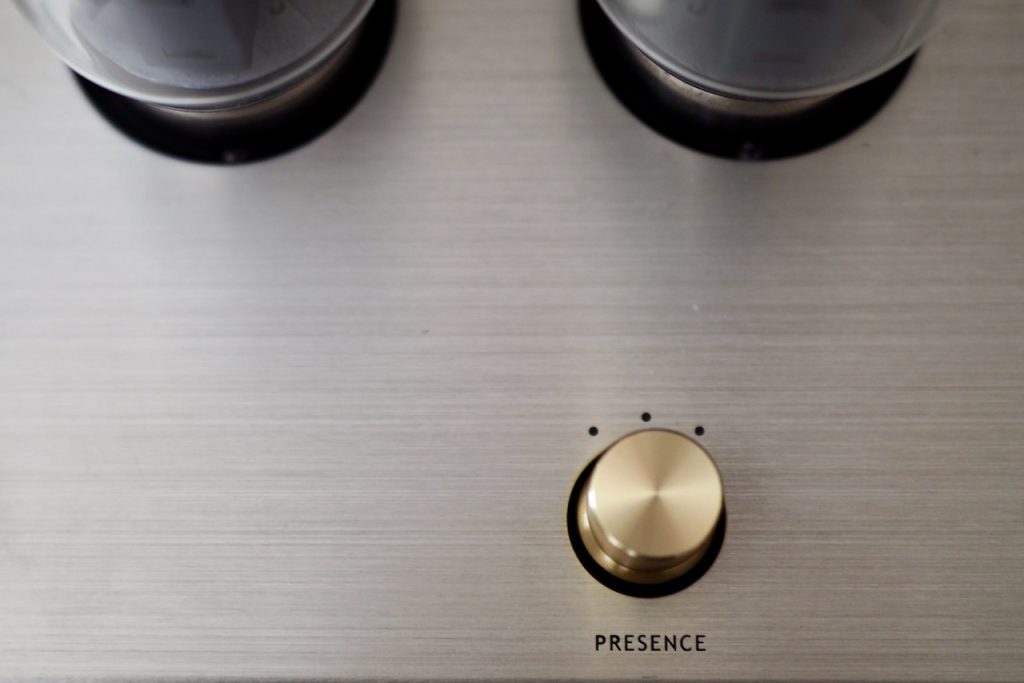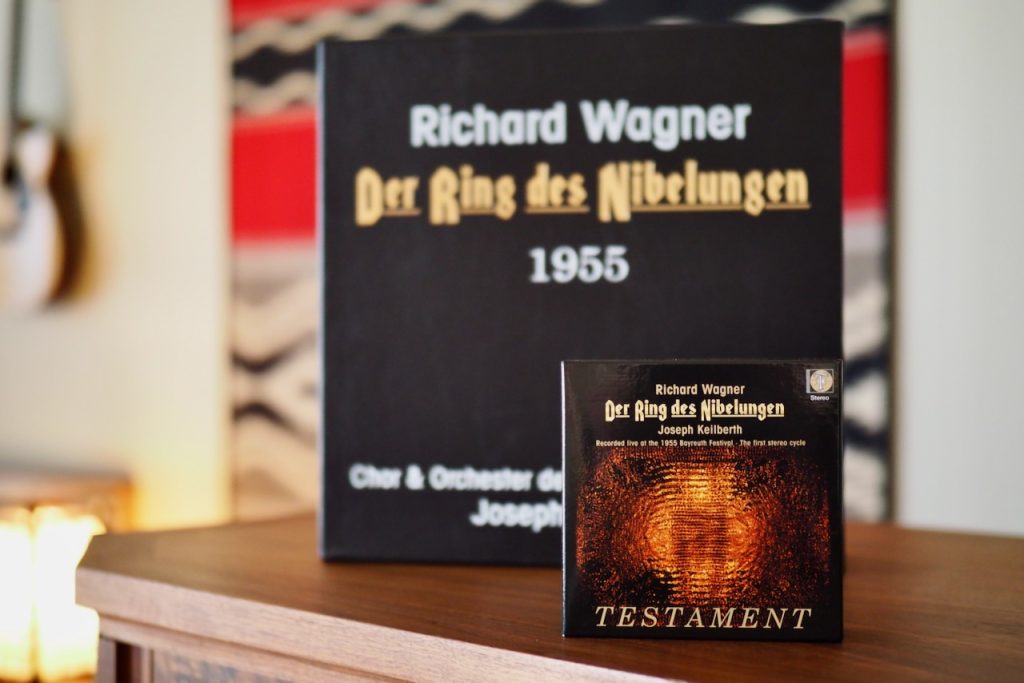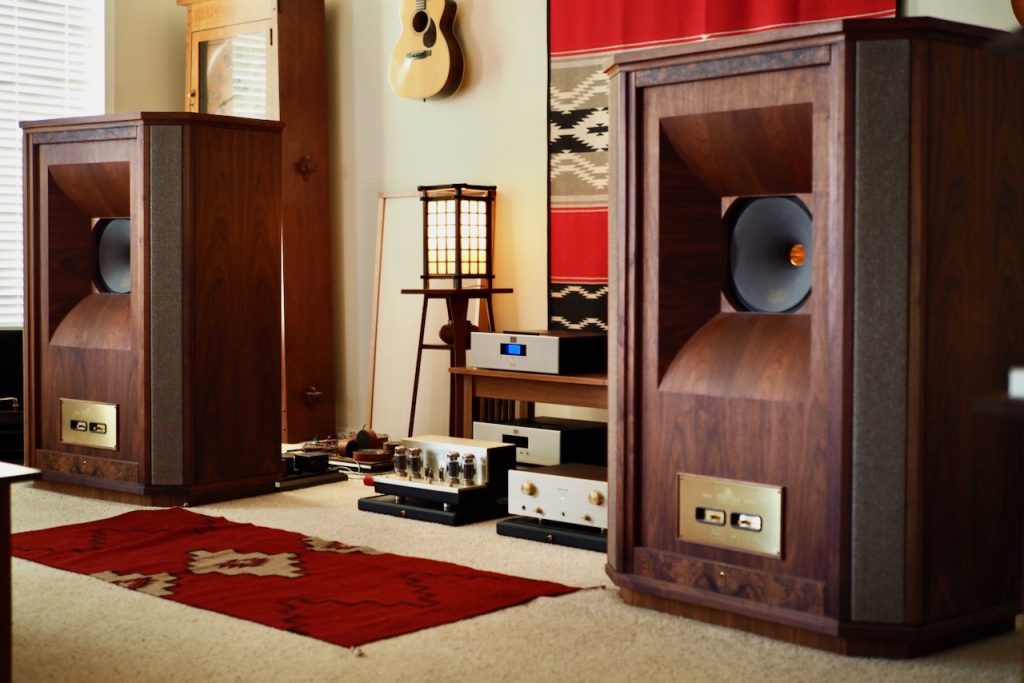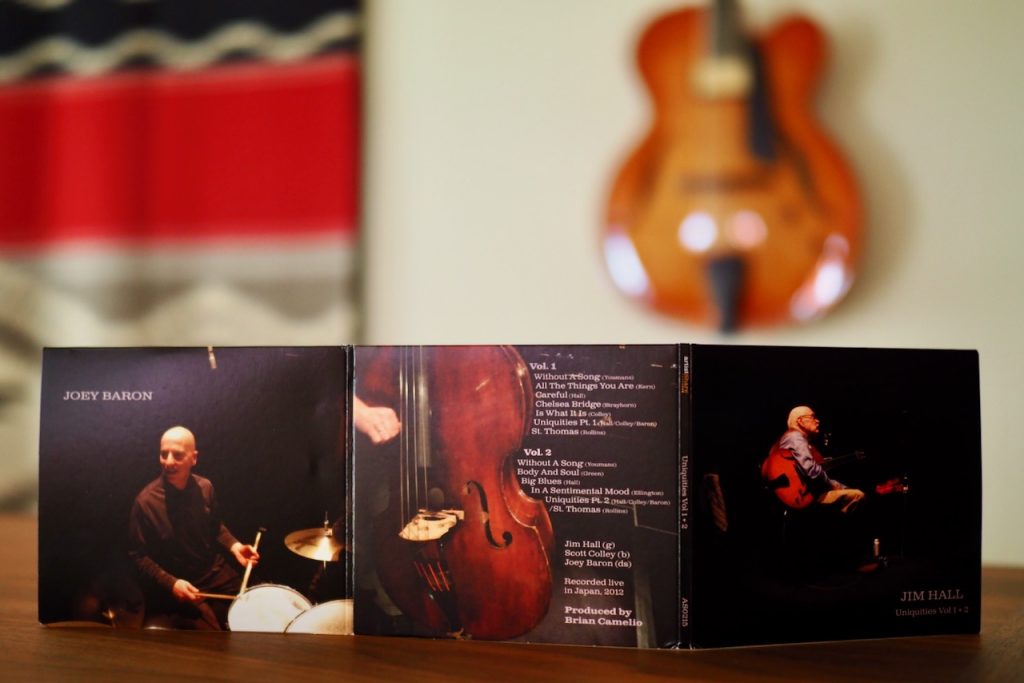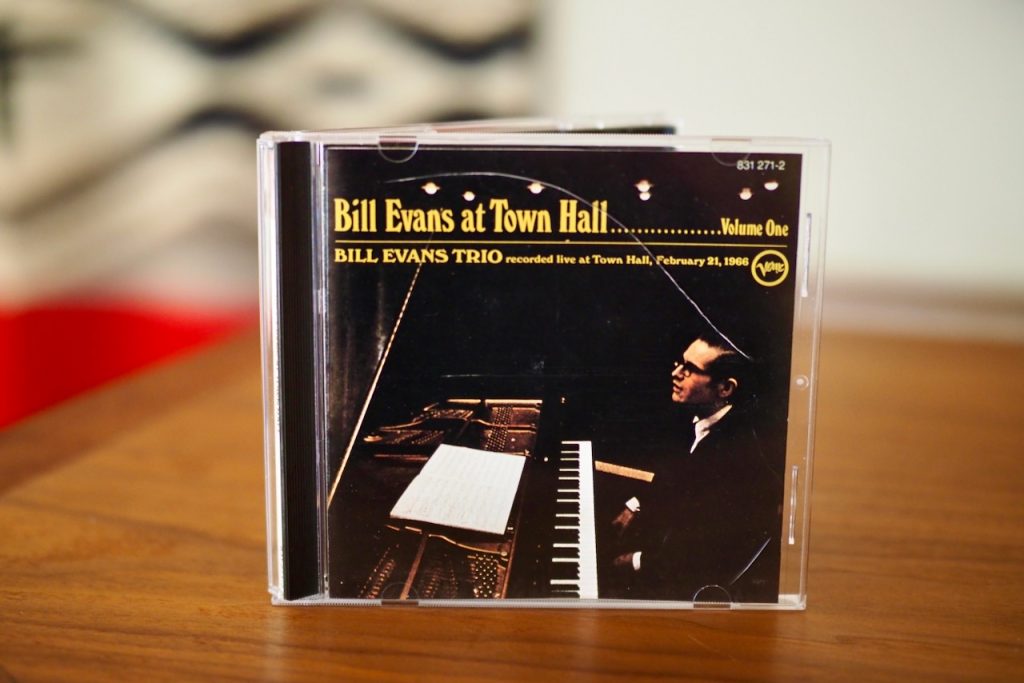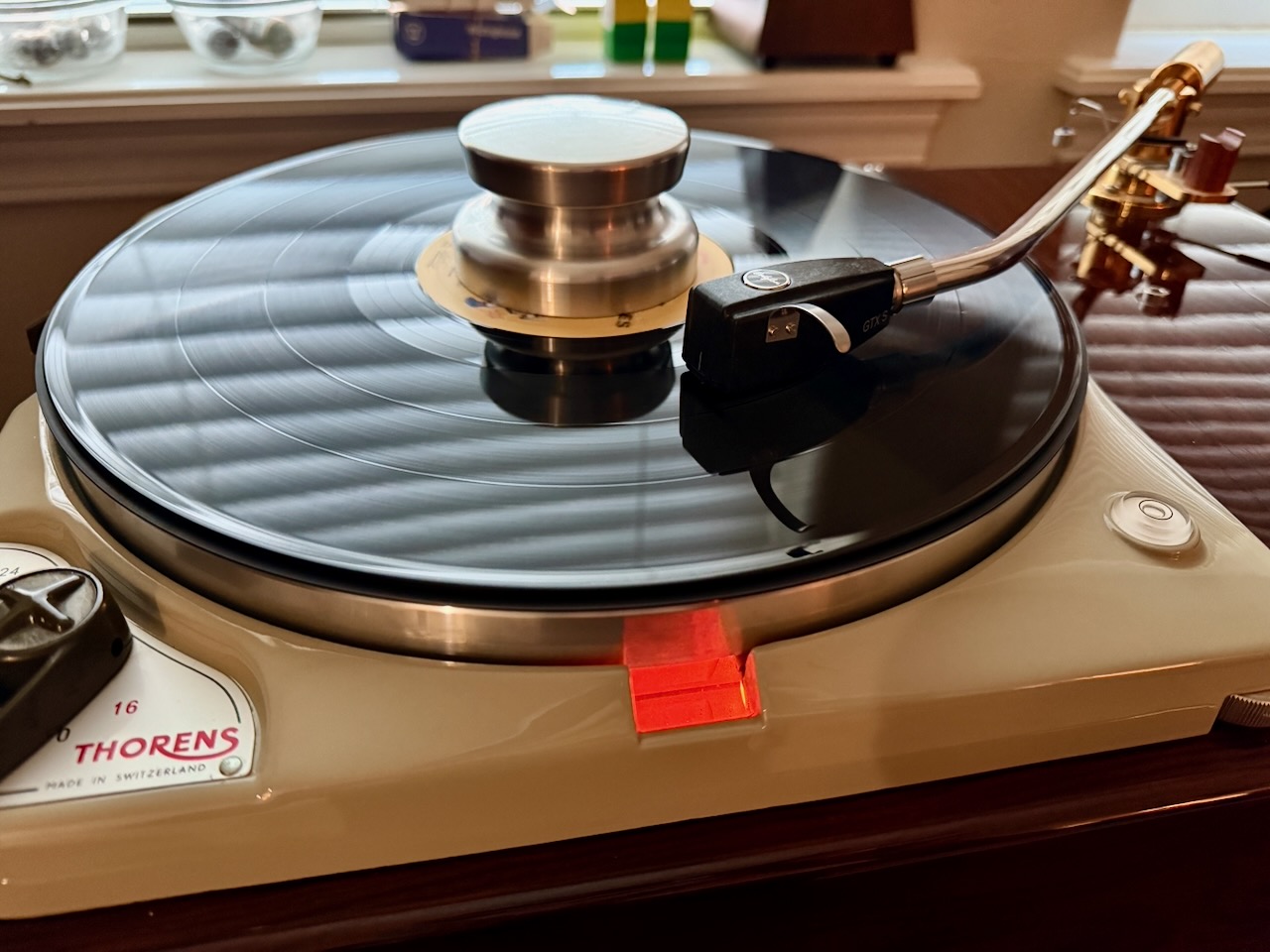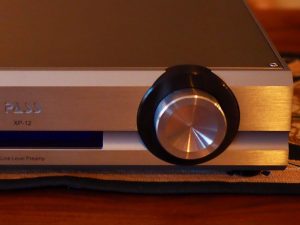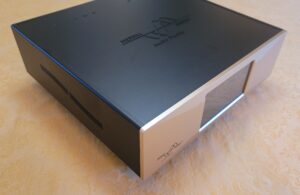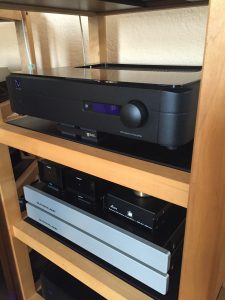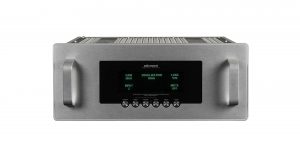Founded in 1964, and for 59 years now, Mactone has continuously manufactured high-fidelity vacuum tube audio components, longer than any other company in Japan.
Steve Mishoe (In Living Stereo) started importing Mactone audio components to North America in late 2018, after visiting the Matsumoto family—who owns and operates Mactone—in Japan.
Steve recently contacted me and asked if I'd like to listen to the Mactone XX-440 line preamplifier (photo above) and MH-120 stereo amplifier (photo below), and I of course said, "Yes!".
Mactone is a highly revered audio company in Japan, but Mactone isn't as well known to North American audio enthusiasts as some of the other Japanese high-fidelity audio marques, which is rather surprising to me given the level of performance I've been hearing from these components.
Steve is trying to heighten that awareness, and get the word out to hi-fi enthusiasts in North America, about what impressive high-fidelity performers these Mactone audio components are.
As an audio writer, its always exciting for me to become aware of a 'new' high-fidelity audio company, and have the opportunity to listen to their components with some of my favorite music.
In the case of Mactone, 'new' refers only to my limited awareness of the company up to now, as Mactone was founded by Kenjiro Matsumoto in 1964, only a year after the classic McIntosh C22 preamplifier was released, and only two years after the classic Marantz 8B stereo amplifier was released.
Unlike Marantz, which was sold to Superscope in 1964, or McIntosh, which was sold to Clarion in 1990, Mactone has been in continuous production for 59 years with founder Matsumoto-san at the helm.
Mactone's enduring presence as a high-fidelity audio company impresses me. There's a reason for that endurance, which is the Matsumoto family's ability to design remarkably musically satisfying audio components, that will bring decades of enjoyment to their owners.
The Matsumoto Family and Mactone
Mactone is a family owned company, founded in 1964 by Kenjiro Matsumoto (center in the photo below), who is now 91 years old, and is still actively engaged in developing Mactone designs. Kenjiro's son Teiichi (left in the photo below), and grandson Daichi (right in the photo below), handle building the equipment, and day to day operations.
Matsumoto-san passing down the vision and passion for his Mactone high-fidelity audio creations through the family generations, to son and grandson, strikes me as an inspiring and heart warming heritage.
I asked Steve Mishoe if he could tell me a little more about the history of Mactone:
"Born in Tokyo, Kenjiro Matsumoto started in the audio business with his father's support when he opened an electronics retail shop. All the while he was studying electronic engineering, and graduated from Tokyo Denki Daigaku University of Electricity."
"In 1964 Matsumoto-san founded Mactone where he began designing and building his first vacuum tube amplifiers and preamplifiers. Quality transformers were always at the top of his quality list in components, and so he began building and winding his own."
"To illustrate how long Kenjiro has been at it, one must understand the technology that was available in the mid 1960s. In order to build a properly matched transformer, Kenjiro had to derive the constant of the transformer by calculating the square root. At first, a hand cranked calculator was used to generate real numbers, but this was extremely time consuming. When the first calculators were available, Kenjiro jumped at buying one. It may be hard to believe now, but the first calculator with a square root function cost 200,000 yen (approximately $1500 USD). Kenjiro didn't have the money to buy it outright so he took out a loan and paid it back over 10 months. After getting the calculator, constant calculations became much easier."
"After many years of perfecting his designs, it became difficult for Kenjiro to properly manufacture the equipment, as lifting and soldering tube amplifiers became difficult for a man in his 80s. "My eldest son helps me make amplifiers. The beginning of a new Mactone", said Matsumoto-san.""
"It was Teiichi, his eldest son, who stood up to the task. Teiichi Matsumoto was born in 1963 in Hachioji, Tokyo. Teiichi liked to listen to records with songs such as "Queen of Sheba" and "007's Theme." He also liked listening to overseas shortwave broadcasts and recording FM broadcasts on cassette tapes. He helped with the family business, receiving an allowance for installing parts on chassis and winding transformers."
"Teiichi-san seemed to have a natural talent for making things. After a three year term, Teiichi retired from the Japanese Self Defense Force. It was the early 90's and he began doing custom mods in a motorcycle shop. All the while he helped his father build Mactone products."
"In 1999, Teiichi-san opened up a Harley-Davidson motorcycle specialty shop called Black Chrome Bike Works. Teiichi loves his Harley-Davidsons dearly, in particular, the 45 degree narrow angle V-twin engines odd beat-like rumble. Teiichi-san still owns Black Chrome Bike Works, and between him and his son Daichi, they manage both the motorcycle and audio businesses."
"Since rejoining Mactone, Teiichi's perfectionistic ways have helped the current Mactone offerings to be better built both inside and out. Teiichi is in charge of building all export products. Once Teiichi inherits the responsibilities of running Mactone, he says, "There is no need to chase a new format like Harley does. It is important not to change Mactone's uniqueness and design philosophy."
The Mactone Design Philosophy
"We believe that it is impossible to create an amplification system that produces sound closest to a live performance without a vacuum tube based circuit. A properly designed tube based circuit allows for hours of fatigue free listening. In order to realize good sound, Mactone has designed unique proprietary circuitry that pushes the envelope of performance for vacuum tubes. Our tube amplifiers and single-stage preamplifiers, are assembled and adjusted by hand without using cheaper printed circuit boards."
"Mactone has always focused on improving sound quality with research and development, and has developed its own circuit configuration. Also, when designing output transformers, including power transformers, we clarify the interrelationship between the circuit and the output tube, and determine the optimal winding method and core quality that improves sound quality. Moreover, all circuits are point to point wired by hand. In addition, third-order distortion, which adversely affects the tone, is extremely low in vacuum tube circuits compared to semiconductor designs."
"We believe that negative feedback in tube preamplifiers negatively affects performance. Mactone preamplifiers are non-feedback designs."
"Kenjiro and Teiichi are currently working on developing a power amplifier design utilizing 300B vacuum tubes in a parallel push-pull configuration. Teiichi is excited about the current Mactone and sees a long and bright future for company."
The Mactone XX-440 Line Preamplifier ($11,500 USD) and MH-120 Stereo Amplifier ($13,500 USD)
The Mactone XX-440 line preamplifier is nicely constructed with a high level of build quality that is comparable to other premium high-fidelity marques.
The faceplate is finished in an attractive gold finish that gives the XX-440 an elegant and refined appearance.
The bottom of the chassis is supported by four high-quality footers.
Let's do a 'walk around' of the Mactone XX-440 line preamplifier and explore its features.
On the front of the Mactone XX-440 line preamplifier, we see the input selector knob on the top left, with input selections for six sources: CD, DVD, Line I, Line II, Line III, and Line IV.
Below and to the left of the input selector knob is the headphone output. The headphone output is driven directly from the preamplifier circuit.
To the right of the headphone input is a tape source selector switch, which allows for selection between two tape decks, say a cassette deck, or a reel to reel, for example.
At the bottom middle of the front panel is the power on-off switch. Let me add a "Hooray!" for the sensible location of the front panel power switch, which makes it easy to turn the XX-440 on and off when placed in an equipment rack.
To the right of the power switch is the balance control, and in the upper right of the front panel is the volume control.
Around back of the Mactone XX-440 line preamplifier, starting on the left side, we see a dedicated IEC power cord connector, which makes it easy to pair the XX-440 with a larger diameter high-quality power connector like those from Furutech, for which I award another "Hooray!" to Mactone.
To the right of the IEC connector is the fuse holder.
Towards the middle of the back panel are two pairs of RCA preamplifier output connectors. Two pairs of RCA connectors allows for a bi-amp arrangement for two amplifiers, or alternatively, one pair of connectors could be used for a stereo amplifier or a pair of monaural amplifiers, and the extra pair of RCA outputs could be used to connect a dedicated headphone amp to the system for those with particularly difficult to drive headphones.
To the right of the pre out RCAs are four pairs of tape in-out RCAs for connecting two tape recorders.
To the right of the tape in-out RCAs are four pairs of RCA inputs for connecting line-level sources such as phono stage, an FM tuner, a reel to reel, etc.
To the right of the of the four pairs of RCA inputs is a pair of RCA inputs for connecting a DVD player, and directly above the DVD input is a grounding post. To the right of the DVD player inputs is a pair of RCA inputs for connecting a CD player. Both the DVD and CD inputs are electrically the same as the other line level inputs, so if you don't have CD or DVD sources to connect, you can connect any other line level source you wish.
That's it for exploring the external features of the XX-440, now let's take a look inside the Mactone XX-440.
The XX-440 preamplifier, like all Mactone products, is completely point to point wired. The main goal for all the Mactone preamplifiers is to lower output impedance and increase bandwidth via a single-ended push-pull circuit (SEPP).
The XX-440 is an output transformerless design (OTL). The output is divided into two levels with 12AU7 tubes operating in parallel, so the overall circuit consists of four parallels and a total of four SEPP circuits. An intriguing design.
Since the XX-440 utilizes a positive and negative one-sided power supply (right side in the photo above), the output goes through a capacitor. The initial stage is cathode coupling and phase inverting via the 12AU7. Loop negative feedback is not applied, and the power supply uses a choke.
The Mactone XX-440 is thoughtfully designed, with an abundance of user-friendly features, utilizes high-performance amplification circuitry, point-to-point wiring, and a robust build quality.
Visitors to my listening room have complimented the attractive and elegant appearance of the gold-toned finish of the Mactone XX-440 line preamplifier and MH-120 stereo amplifier.
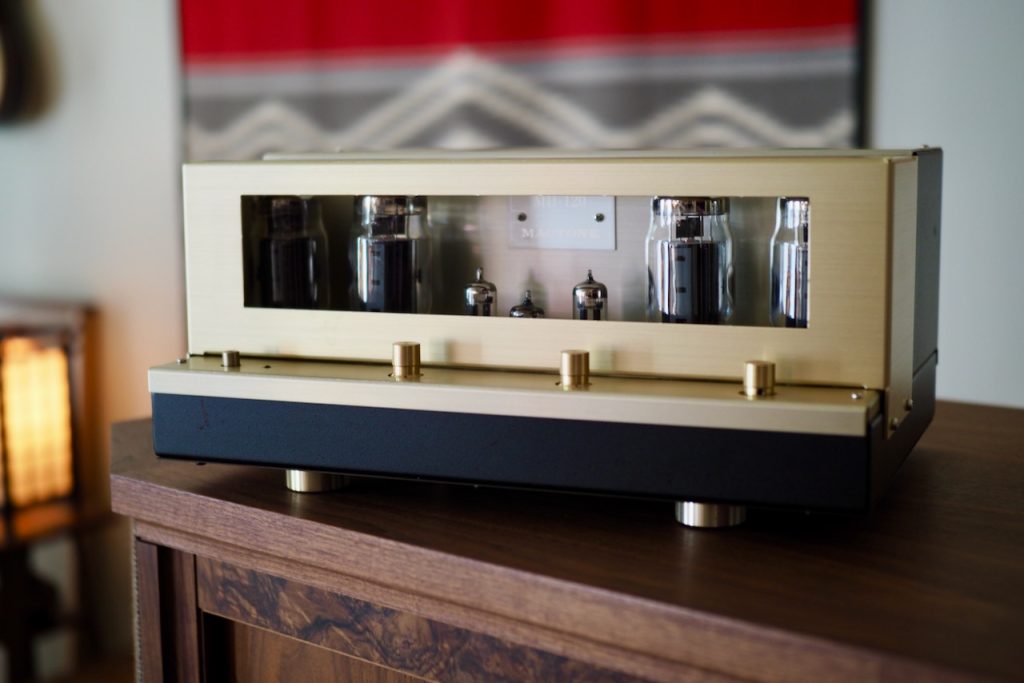
Now lets do a 'walk around' of the Mactone MH-120 stereo power amplifier.
First of all, the finish of the MH-120 stereo amplifier matches that of the XX-440 preamplifier, with attractive gold-toned top covers, which are contrasted and complimented by the matte black finished chassis. On the bottom of the chassis there are four high-quality footers.
There is a matching tube cage provided to minimize potential contact with the hot vacuum tubes, and I like the way the tube cage looks when in place. Steve Mishoe told me he thinks the MH-120 sounds better with the tube cage removed, so that's how I listened to it for this review.
As with all vacuum tube amplifiers, you'll want to make sure to keep curious spouses, friends, pets, and children from touching the hot exposed tubes.
On the left of the chassis is the power on-off switch (with a red power-on indicator light next to it), which earns Mactone another "Hooray!" from me for locating the power on-off switch on the front of the chassis for an easily accessible location when installed in an equipment rack.
In the center front of the chassis are separate level controls for the right and left channels.
On the right side of the chassis is a three position "presence adjustment knob" that allows the listener to optimize the MH-120's performance for room traits, or for variations in recording quality of albums.
The left setting is flat and offers the most detail, the middle setting has slightly less bass for more excitable rooms or recordings with too much bass, and the third setting has an attenuated treble for brighter rooms or recordings with too much treble.
You might be tempted to think of the presence adjustment knob as a simple potentiometer based tone control, but its not. Rather, the presence knob works by varying the amount of negative feedback. The left setting has the least amount of negative feedback at 2 dB, the middle position has 4 dB of negative feedback, and the right position has 4 dB of negative feedback at 50Hz.
I really like Mactone's inclusion of the presence adjustment knob on the MH-120 amp, I wish every manufacturer offered that kind of feature, and so I award Mactone another "Hooray!". Well done Mactone!
Recordings can vary all over the place in how well they are balanced across the bands that make up the audio spectrum. What I've found is that the MH-120 amp's presence knob works really well for bringing sound quality back into balance when things are a little out of whack in a recording, which I'll discuss with some examples in the listening portion of this article.
For example, if the presence or brilliance bands of recordings are goosed up too much during mastering, like they are in some albums marketed to audiophiles, setting the MH-120 amp's presence knob to the right setting that attenuates treble slightly helps calm down those albums.
When the bass region has been boosted too much during mastering it makes the bass sound boomy, and the middle setting of the presence knob corrects for too much bass boost in a recording.
For well sorted recordings, the left setting of the presence knob provides for a flat response and provides the most detail from the recordings.
Note: The Teach Me Audio website has an excellent discussion of how varying the boost of each of the seven frequency bands of the audio spectrum in a recording during mastering can change the overall sound of the recorded music. It's worth reading, and helps one understand better what you are hearing from different albums played back through your audio system, and why the inclusion of the presence adjustment feature in the MH-120 amp is such a great idea.
The vacuum tubes you see, left to right, are a pair of Tung-Sol KT120 beam pentode power tubes for the left channel, an Electro-Harmonix 12BH7 twin triode driver tube for the left channel, a NOS JAN GE 6189W twin triode input tube (12AU7WA / ECC82 equivalent), another Electro-Harmonix 12BH7 twin triode driver tube for the right channel, and a pair of Tung-Sol KT120 beam pentode power tubes for the right channel.
Around back of the MH-120, left to right, are a pair of binding posts for the right channel, a fuse holder, an IEC connector, a pair of binding posts for the left channel, and a pair of RCA inputs for connecting a preamplifier.
Design-wise, the MH-120 utilizes a pair of Tung-Sol KT120s in each channel, in a self-biasing, low negative-feedback, push-pull, Class AB circuit to deliver 65 watts of output power per channel.
Mactone chose the KT120 over the other tubes in the 6550/KT88/KT90 family for its higher power output, increased ruggedness and long life, and superior dynamic and tonal qualities.
Tung-Sol describes the KT120 (specs HERE) as a robust and long-life vacuum tube rated for designs of up to 200W per channel, and "… the KT120 is impervious to overload, delivering peak power with extreme reliability and almost infinite tube life."
The KT120s in the MH120 ought to last a good long time with their easy load and comparatively modest power output.
Mactone winds its own transformers for the MH120 amp to achieve the performance level they desire, and the transformers are of the "orient core" variety, which orients the grain of the silicon steel for better performance.
The small 'transformer' you see in the above photo is not a transformer, but rather a choke, that is placed in the high-voltage supply and filters out any residual hum/noise in the power supply.
In the photo below you can see the elegant point-to-point wiring used by Mactone.
The Mactone MH-120 is an attractively finished stereo amplifier, that has a high quality of build level, a number of thoughtful user features, like the presence adjustment knob, the left and right channel level controls, and a power on-off switch located on the front of the chassis.
Audio System for this Review
For this article I used my usual Tannoy Westminster Royal SE loudspeakers that have been hot-rodded with an internal rewire using vintage Western Electric WE16GA tinned-copper wire, and custom external Duelund crossovers utilize pure silver Duelund CAST components in the high-frequency / midrange circuit, and Duelund CAST pure copper components for the rest, with Duelund DCA16GA tinned-copper wire connecting everything together.
The Mactone MH120 stereo amplifier was connected directly to the external Duelund crossovers with Duelund DCA16GA tinned-copper speaker cables.
The Mactone XX-440 preamplifier was connected to the MH120 power amplifier with Duelund DCA16GA tinned-copper interconnects.
The Audio Note (UK) CD 5.1x CD player ($30,850 USD, in for review) was used as the source, and was connected to the XX-440 preamplifier with Belden 8402 microphone cable interconnects.
The wall AC outlets consisted of Acoustic Revive CB-1DB receptacle base plates, CFRP-1F carbon fiber outlet plates, and custom modified Acoustic Revive modified Oyaide R-1 receptacles. AC from the outlet to the Acoustic Revive RPT-6 Absolute NCF Power Distributor was via an Acoustic Revive Absolute power cable, and power cables to components were a mix of Acoustic Revive Power Reference TripleC NCF AC power cables (amplification components), and Acoustic Revive Absolute power cables (source components).
Listening Impressions
I've been listening to all kinds of recorded musical performances with the Mactone XX-440 line amplifier and MH-120 stereo amplifier: jazz, classical, opera, folk, blues, rock & roll, low-fidelity, high-fidelity, and recordings from all the eras of the recording arts.
I have been greatly impressed by the musicality of the Mactone XX-440 & MH120 combination during those listening sessions, and have been mulling over how I could best describe their overall voicing for a while now.
Here's my take on it: Imagine if you will, one of the great vintage amplification pairings from the Golden Age of Audio that we audio enthusiasts enthuse about, like the Marantz Model 7 preamplifier that was released in 1958, paired with the Marantz 8B stereo amplifier that was released in 1961, for example.
Now imagine that those musically adept Marantz Golden Age components had been refined continuously over the next 60 years by company founder Saul Marantz, incorporating new design insights, higher performing circuits, and higher quality internal components, that would complement their performance when paired with today's premium high-performance sources and loudspeakers.
I would imagine those evolved Marantz components would maintain their desirable vintage-like musicality, but with oodles more refinement than their vintage counterparts could ever dream of.
That's kind of how I think of the overall performance of the Mactone XX-440 line preamplifier and MH-120 amplifier combination.
The Mactone XX-440 line preamplifier and MH-120 amplifier combination possess a mix of traditional and contemporary design elements, which results in an impressive classic vintage-like musicality. That classic Mactone voicing, along with sixty years of continual Matsumoto-san guided refinement, has produced one of the most musically satisfying high-fidelity audio presentations I've come across.
I see the Mactone XX-440 preamplifier and MH-120 stereo amplifier as contemporary classics. They are the antitheses of the thin, forward, analytical, and musically challenged designs that were popular with audiophiles for a period of time, and frankly they are a true breath of fresh air in the hotly contested arena of high-fidelity audio electronics.
The Mactone XX-440 pre and MH-120 amp have a full-bodied, natural, tonally beautiful, warm, liquid, dynamic, visuospatially refined, and musically adept presentation that unfailingly conveyed the artistic, dramatic, and emotional elements to me during listening sessions.
I've been listening a lot to the latest Hilary Hahn album, Eclipse, which fellow audio enthusiast Mike Rubey recommended to me: "If you don't have it yet get yourself a copy of Hilary Hahn's latest album Eclipse. It has the Ginastera Violin Concerto on it. I'm not sure anyone else can even play it. Utterly completely mind blowing," said Mike.
Eclipse, the first album Hilary has recorded since the pandemic started, is an example of otherworldly musical performances by Hilary Hahn, courtesy of the digital era of the recording arts (available on CD and LP, and as downloads).
I dropped Eclipse into the Audio Note (UK) CD 5.1x CD player and hit 'play.' A generally rich, warm, natural, sensual, refined, dynamic, and engagingly beautiful musical tonality emerged from my West's to embrace me, caress me, and fill my listening room with the magic that is Hilary Hahn, courtesy of the Mactone XX-440 and MH-120.
Hilary's 1865 J.B. Vuillaume violin's distinctive timbral qualities, and which is capable of both subtle nuances and impressive dynamic response, comes through brilliantly, breathtakingly, courtesy of the Mactone XX-440 and MH-120.
Deutsche Grammophon is often credited as being the "oldest surviving established record company" (established in 1898 by Emile Berliner, although currently owned by Universal Music Group), and has long prided itself at being at the forefront of recording and format innovations.
So for example, with high-fidelity audio equipment like the Mactone XX-440 and MH-120, I could easily hear how Deutsche Grammophon's multi-miking approach decreased the sense of natural acoustic ambient space between instruments on the soundstage, as compared to the more minimalist miking approach of Mercury Living Presence in the 1950s and 1960s (3 omni mics, no spot mics).
Another thing that I noticed when listening to Eclipse was something I've heard from other digital recordings—as opposed to digital transfers from analog recordings - was that there was a very fine-grained low-level "noise" (for lack of a better word) present in the recordings that seems to be one of the defining characteristics of the digital recordings I am familiar with. It's not enough to get in the way of enjoying the musical performances, but it is audible.
That observation is not a condemnation of multi-miking and/or digital recording per se, as each of the eras of the recording arts have their own recording quality bugaboos, but the Mactone XX-440 and MH-120 did provide a deep enough glimpse into the fabric of the recordings that I could hear those fine details, which I think is an altogether useful attribute for high-fidelity audio amplification electronics to possess.
The Mactone components' gorgeous tonality and musicality provided me immense listening pleasure, along with their high level of overall refinement portraying nuance and instrumental tone in extraordinary fashion. This allowed me to hear deeply into the musical performances documented in Eclipse, as well as insights into the sound quality artifacts resulting from DG's approach to recording.
Another performance attribute I noted while listening to Eclipse was that the Mactone MH-120 stereo amplifier's 65 watts of output power lended a luxurious and liquid sense of ease to playback with my 99 dB sensitive Westminster loudspeakers, and of course, provided superb dynamic response.
In terms of dynamic response/range, Eclipse has that remarkable dynamic range that classical music aficionados love, which is aided by digital's greater dynamic range compared to analog, with soft to startling loud dynamic swings all articulately rendered, which the Mactone XX-440 and MH-120 artfully displayed.
The MH-120's 65 watts of output power will also allow it to drive a large swath of loudspeakers of moderate sensitivity, which will make it a very versatile amplification choice. Tannoy Dual Concentric owners should take special note, as the Mactone tonal balance was a brilliant match to the very revealing and somewhat fussy midrange / high-frequency horns of my Westminsters, to deliver one of the most well-balanced and natural presentations of music I've ever heard from the big beasts.
Released in 2010 to coincide with the 100 year anniversary of Django Reinhardt's birth, Martin Taylor and his Spirit Of Django band's album, Last Train To Hauteville, is an album I continue to enjoy over the long term.
It seems only natural that with his Roma people heritage that Martin Taylor would want to do a tribute album to the great Roma guitarist Django Reinhardt, and what a superb tribute to Django Last Train To Hauteville is, with its amazing musicianship and beautiful recording quality.
Audiophiles will want to know that the Mactone XX-440 and MH-120 delivered a nice wide soundstage, with refined and full-bodied imaging attributes, from the Last Train To Hauteville.
I didn't hear that sense of spooky holographic imaging from the Mactone XX-440 & MH-120 pairing that I hear from the very best single ended triode amplifiers (SET), nor would I expect to given its push-pull design, but I thought imaging was comparable with other high-fidelity push-pull amplifiers I've heard, and probably was more realistic when compared to live performances than are most SET amplifiers.
From a musical standpoint, the Mactone XX-440 and MH-120 displayed beautiful tonality, along with realistic musicality attributes like timbre, tempo, dynamics, tone color, and so forth, while delivering big doses of the emotional feelings associated with the songs on the album.
Overall, the Mactone XX-440 and MH-120 provided a very well-balanced and musical presentation of music that made listening to favorite albums like the Last Train To Hauteville a joy.
While listening to a wide suite of albums, I found the Mactone XX-440 and MH-120 to be extremely well-balanced across the audio spectrum, from the sub bass region all the way up through the brilliance region. That canny balance allowed me to easily hear if recordings had a bit too much boost or cut in one of the audio spectrum regions, which is where the presence adjustment on the Mactone MH-120 stereo amplifier comes into play.
Waltz for Debby by the Bill Evans Trio is a longtime jazz favorite of mine, as well as for a lot of audiophiles, and has been remastered/reissued a number of times over the years in various formats. I have the '24 Karat Gold Limited Edition' of Waltz for Debby from Analogue Productions (CAPJ 009), that was mastered by Doug Sax at the Mastering Lab way back when.
While generally well-balanced in the bass region, at times Scott Lafaro's bass can sound a little overblown on this CD. A quick turn of the presence adjustment setting to its middle position brings the bass back in line for a more well-balanced presentation. I also noticed that the middle setting resulted in a little softer and more distant sounding overall presentation on Waltz for Debby, as well as a little less distinct imaging.
However, the overall net benefit of being able to reduce bass boost far outweighed the slight reduction in imaging capability in delivering an enjoyable listening session with Waltz for Debby, and still I got a real sense of solid imaging, a wide and deep soundstage, with lots of nuance in technique and subtle overtones in evidence, for an overall presentation that was really superb in terms of musicality and sound quality.
One of the things I've really been enjoying over the last few years is exploring the great musical performances documented in the acoustic (1877 to 1925) and electric (1925 to 1945) eras of the recording arts. The recordings of those eras were lower in fidelity than the best magnetic era recordings, having less low and high-frequency extension, and a bit more noise, but the great musical performances documented in those eras can make for enjoyable, if not profound, listening sessions.
Take for example The Dream Ring of the Der Ring Des Nibelungen on the Immortal Performances label (photo above), which features cherry-picked performances of the best voices in their Ring roles from the "Golden Age of Wagner heard at the Metropolitan Opera and at Covent Garden in the 1930s … which have never been surpassed in vocalism and interpretation."
This lovingly assembled Dream Ring features transfers from electric era NBC transcription discs from the 1930s where recordings were made relay style, where every 15 minutes a new disc was required to get continuous recordings: "… during the 1930s, the instantaneous process broke off recording every 15 minutes, with a second recording supposed to start immediately before the first recording broke off … The difference in sound however, can be anything from minor to substantial."
The performances themselves flow together very well, but the sound quality could be quite variable at different points during my listening sessions, which made for a great laboratory for experimenting with the different settings of the presence adjustment knob.
The presence adjustment knob was quite useful in this sort of context, with one of the three settings bringing out the best for a given transcription disc transfer. It wasn't always intuitive which setting would provide the best result with these electric era recordings, but trying each setting takes only seconds, and selecting my preferred presence setting was quick and easy, and the result was me immensely enjoying those profound performances from the ring cycle.
So the moral of this story is that when one is listening to music, just take a few seconds to try the different presence adjustment settings to find out which one flatters the album you are listening to the most. There's no wrong setting, as its all subjective, so have fun with it and see how the MH-120's presence adjustment feature affects the albums you are listening to.
One can't really talk about the Wagner Ring Cycle without paying tribute to the Joseph Keilberth 'Der Ring des Nibelungen' from the 1955 Bayreuth Festival, originally recorded by Decca, and available as a 19 LP box set or 14 CD box set (above), which were remastered for the Testament label releases.
Notably, Decca's recordings of the 1955 Bayreuth Festival were in stereo, making this the first stereo version of the Der Ring des Nibelungen. Notable also, as typically the stereo magnetic recording era is typically considered to be from about 1957 to 1975, so this is a very early example of a stereo magnetic recording.
While the overall sound quality of the later stereo magnetic era recordings of the Keilberth Ring are of higher-fidelity than the 1930s NBC electric era recordings featured in the Immortal Performances Dream Ring, there are still portions of Decca's recordings that can benefit from a little experimentation with the Mactone MH-120's presence adjustment. My recommendation is to just try the different presence settings, have fun with them, and pick the one you like the best.
Ok, let me tell you a little more about the overall sound quality and musicality of the Mactone XX-440 & MH-120 combination when listening to these early stereo Decca recordings from the 1955 Bayreuth Festival.
The Mactone XX-440 line preamp and MH-120 amplifier provided an immense sense of scale from the 1955 Bayreuth Festival performances, with spectacular dynamic range, a wide and deep soundstage, and with well localized imaging across the depth and width of the soundstage.
The Mactone components don't project one of those artificial sounding ultra-resolution and analytical style of presentations. Rather, their sound quality is much more natural and accessible than that. There was plenty of recorded nuance in evidence, as well as those fine visuospatial cues that aid imaging and soundstage presentation. I particularly admired how realistic and beautiful sounding instrumental timbre was through the Mactone XX-440 & MH-120.
Perhaps even more importantly, the Mactone XX-440 & MH-120's gorgeous tonal qualities, superb musicality, and high-fidelity sound quality brought those nearly 70 year old recordings to breathtaking life. With the Mactone components I was in constant awe of the performances documented in Keilberth's Ring, and found myself caught up in the emotional ecstasy of the music.
Certainly Jim Hall is one of the greatest jazz guitarists to have ever lived. My friend David Gitlen studied with Jim, attended many of his concerts, and has told me many enjoyable stories about Jim over the years.
When I saw that ArtistShare was releasing a new album of previously unreleased live recordings of the late Jim Hall, Uniquities, I quickly ordered copies for David and myself.
The performances on Uniquities were recorded live in Japan, 2012, and feature Jim (guitar), Scott Colley (bass), and Joey Baron (drums).
The selections on this 2 CD set were "… carefully curated to demonstrate how incredibly innovative Jim was and to reflect his unrelenting search for that combination of stunning beauty and an ever-evolving modern approach to music."
The recording quality is very good, and faithfully captures Jim's beautiful tone, which I can attest to, as in the background of the album photo above you can see the same model of guitar that Jim played at the concert, a Sadowsky 'Jim Hall Model'.
Uniquities is a live recording, and I got a real sense of being there at the performance through the Mactone XX-440 and MH-120. Jim, Scott, and Joey were positioned between my loudspeakers, and were relatively close-mic'd, so I could hear all of the subtle nuance in their playing.
Whether it was Jim playing innovative lines, or subtly comping, the tone was realistic and beautiful through the Mactone components, just like in life.
Listening to Uniquities through the Mactone components was the musical equivalent of comfort food. Beautiful music and beautiful sound quality that just made me feel good to experience it.
Another live album with great musical performances is the Bill Evans at Town Hall album, featuring Bill Evans (piano), Chuck Israels (bass), and Arnold Wise (drums), recorded live at Town Hall in New York in 1966.
The original analog tape sessions were produced by Creed Taylor, and engineered by Rudy Van Gelder. The original stereo master tapes were remastered by Dennis Drake (PolyGram Studios) for digital, and Dennis did an absolutely superb job to give one of the most well-balanced recordings across the audio spectrum of Bill Evans I've come across. No presence region adjustment needed here, the MH-120's left setting (flat response) was perfect for Bill Evans at Town Hall in my system.
The location of images on the soundstage were a little bit odd with Bill Evans at Town Hall, as can be the case with live recordings, which I could easily hear with the Mactone XX-440 and MH-120's excellent portrayal of visuospatial information.
Bill Evans piano was closely mic'd, so I could hear all kinds of beautiful overtones, dynamic gradations, and tone color distinctions in utterly natural fashion, through the XX-440 and MH-120. Speaking of utterly natural, the audience applause at the end of each number was perhaps the most natural sounding recorded applause I've heard.
If you are a fan of Bill Evans like I am, and don't yet have Bill Evans at Town Hall, I suggest you add it to your short list of albums to get. The album is available on both CD and vinyl.
I hope those few examples covering a variety of musical styles from different eras of the recording arts give you a feel for the overall performance of the Mactone XX-440 line preamplifier and MH-120 stereo amplifier.
There's something really special going on with the performance of this Mactone combination of XX-440 and MH-120. They delivered ravishingly beautiful musical performances from pretty much any albums I threw at them, from any recording era, of any fidelity, along with a lofty level of refinement that I've only rarely heard from competing audio components.
Summary and Conclusions
The Mactone XX-440 line preamplifier ($11,500 USD) and MH-120 stereo amplifier ($13,500 USD) are hand-crafted, point-to-point wired, premium vacuum tube amplification designs that have a classically elegant appearance, and a build quality consistent with other high-fidelity audio components in their price range.
The Mactone tonal balance is one that I am sure will impress many listeners, and it certainly did impress me. The Mactone XX-440 line preamplifier and MH-120 amplifier pairing's mix of traditional and contemporary design elements results in a rich, highly refined, and naturally warm vintage-like classic musicality, one that is complemented by smartly portrayed audiophile-style visuospatial sound quality attributes.
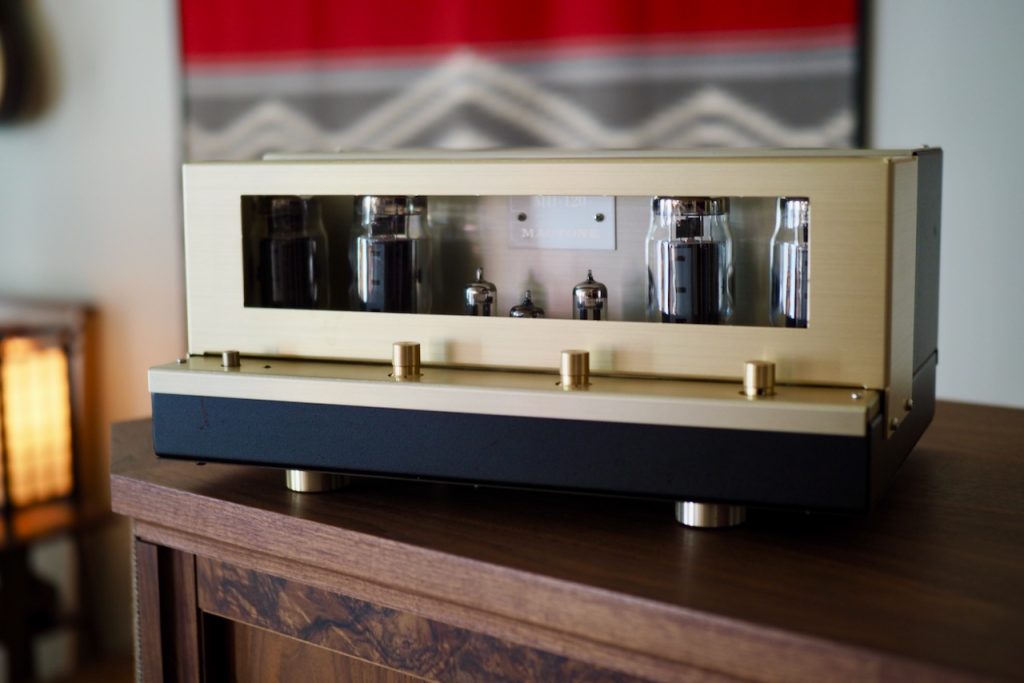
The overall Mactone persona is one of beautiful and natural tonality, dynamic prowess, a liquid and refined presentation that represents vacuum tube amplification at its best, and possessing a rather uncanny ability to strongly connect me as a listener to the artistic and emotional attributes of recorded musical performances.
From a user friendly perspective, there are a number of thoughtful features incorporated into the design of the Mactone components: the presence adjustment feature, the easy to reach front panel power switches, and the use of dedicated IEC AC inlets that makes it easy to use premium power cords with large diameter AC plugs.
If you are a Tannoy Dual Concentric owner, like I am with my Westminsters, the Mactone is a dream match to my sometimes fussy West's.
The Mactone tonal balance, and the MH-120's 65 watts per channel of output power, will also make it a good match for most loudspeakers.
I really loved the performance of these Mactone components, with their rich and natural sounding musicality, their refined visuospatial attributes, and their ability to deeply immerse me into the artistic and emotional aspects of musical performances.
I highly recommend the Mactone XX-440 line preamplifier and MH-120 stereo amplifier to those who want to fall in love with audio and their music all over again.
I suspect that 'love' at first listen will be a common response for many auditioning the Mactone XX-440 line preamplifier and MH-120 stereo amplifier combination, and to them I say, "Vive l'amour (may love live forever) in your music listening!"
I would like to thank the US importer, Steven Mishoe, for suggesting I spend some time with the Mactone XX-440 line preamplifier and MH-120 stereo amplifier, and I encourage you to stop by In Living Stereo to hear them for yourself.
As always, thanks for stopping by, and may the tone be with you!
Mactone XX-440 Line Preamplifier
Retail: $11,500 USD
Mactone MH-120 Stereo Amplifier
Retail: $13,500 USD
Mactone Japan
Mactone USA Importer - In Living Stereo




